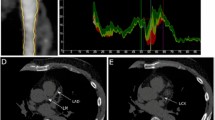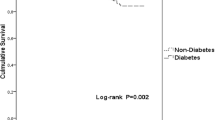Abstract
The purpose of this study was to investigate the difference of coronary artery disease (CAD) severity and extent as well as plaque characteristics between patients with either one of hypertension (HT), diabetes mellitus (DM) or dyslipidemia (DL). We retrospectively reviewed the records of 1,161 patients (HT 442, DM 77, DL 248, no disease 394) who underwent coronary computed tomography angiography. Stenosis severity was classified as normal, non-obstructive (1–49 % stenosis), moderate (50–69 % stenosis) or severe (≥70 % stenosis). Segment involvement score (SIS) and segment severity score (SSS) was calculated. We defined patients at risk as patients with obstructive CAD or non-obstructive CAD with extensive disease (SIS ≥ 5). Plaque characteristics were evaluated including positive remodeling, low attenuation and spotty calcification. Obstructive CAD was most frequent in DM patients, followed by HT and DL patients (34, 19 and 15 %, respectively, p < 0.0001). DM patients had more extensive disease than HT and DL patients (SIS 3.1 vs 2.1 vs 1.4, SSS 4.0 vs 2.7 vs 2.0). DM patients were more at risk than HT and DL patients (p < 0.05). The prevalence of positive remodeling, low attenuation and spotty calcium were all highest in DM patients (p < 0.005, vs HT and DL), while low attenuation was more frequent in DL than HT patients (p < 0.005). The median calcium score of HT and DM patients were higher than DL patients (p < 0.01 and p < 0.005, respectively), while no significant difference was observed between HT and DM patients. In conclusion, DM patients possessed more high risk plaque and obstructive as well as extensive CAD compared with HT and DL patients. Coronary calcification was similarly high in HT and DM patients. Low attenuation plaque was more frequent in DL than HT patients.



Similar content being viewed by others
References
Epilogue Braunwald E (2006) What do clinicians expect from imagers? J Am Coll Cardiol 47:C101–C103
Kamimura M, Moroi M, Isobe M et al (2012) Role of coronary CT angiography in asymptomatic patients with type 2 diabetes mellitus. Int Heart J 53:23–28
Ibebuogu UN, Nasir K, Gopal A et al (2009) Comparison of atherosclerotic plaque burden and composition between diabetic and non diabetic patients by non invasive CT angiography. Int J Cardiovasc Imaging 25:717–723
Loffroy R, Bernard S, Sérusclat A et al (2009) Noninvasive assessment of the prevalence and characteristics of coronary atherosclerotic plaques by multidetector computed tomography in asymptomatic type 2 diabetic patients at high risk of significant coronary artery disease: a preliminary study. Arch Cardiovasc Dis 102:607–615
Motoyama S, Sarai M, Harigaya H et al (2009) Computed tomographic angiography characteristics of atherosclerotic plaques subsequently resulting in acute coronary syndrome. J Am Coll Cardiol 54:49–57
de Araújo Gonçalves P, Garcia-Garcia HM, Carvalho MS et al (2012) Diabetes as an independent predictor of high atherosclerotic burden assessed by coronary computed tomography angiography: the coronary artery disease equivalent revisited. Int J Cardiovasc Imaging 29:1105–1114
Rana JS, Dunning A, Achenbach S et al (2012) Differences in prevalence, extent, severity, and prognosis of coronary artery disease among patients with and without diabetes undergoing coronary computed tomography angiography: results from 10,110 individuals from the CONFIRM (COronary CT Angiography EvaluatioN For Clinical Outcomes): an InteRnational Multicenter Registry. Diabetes Care 35:1787–1794
Kuzuya T, Nakagawa S, Satoh J et al (1999) Report of the Committee of Japan Diabetes Society on the classification and diagnostic criteria of diabetes mellitus. J Jpn Diabet Soc 42:385–404
Teramoto T, Sasaki J, Ueshima H et al (2007) Japan Atherosclerosis Society (JAS) guidelines for prevention of atherosclerotic cardiovascular diseases. Japan Atherosclerosis Society, Tokyo, Japan, 6 (article in Japanese)
Morise AP, Haddad WJ, Beckner D (1997) Development and validation of a clinical score to estimate the probability of coronary artery disease in men and women presenting with suspected coronary disease. Am J Med 102:350–356
Agatston AS, Janowitz WR, Hildner FJ et al (1990) Quantification of coronary artery calcium using ultrafast computed tomography. J Am Coll Cardiol 15:827–832
Raff GL, Abidov A, Achenbach S et al (2009) SCCT guidelines for the interpretation and reporting of coronary computed tomographic angiography. J Cardiovasc Comput Tomogr 3:122–126
Nakazato R, Arsanjani R, Achenbach S et al (2014) Age-related risk of major adverse cardiac event risk and coronary artery disease extent and severity by coronary CT angiography: results from 15187 patients from the International Multisite CONFIRM Study. Eur Heart J Cardiovasc Imaging 15:586–594
Bittencourt MS, Hulten E, Ghoshhajra B et al (2014) Prognostic value of nonobstructive and obstructive coronary artery disease detected by coronary computed tomography angiography to identify cardiovascular events. Circ Cardiovasc Imaging 7:282–291
Kodama T, Kondo T, Oida A et al (2012) Computed tomographic angiography-verified plaque characteristics and slow-flow phenomenon during percutaneous coronary intervention. J Am Coll Cardiol Interv 5:636–643
Hadamitzky M, Achenbach S, Al-Mallah M et al (2013) Optimized prognostic score for coronary computed tomographic angiography: results from the CONFIRM registry (COronary CT Angiography EvaluatioN For Clinical Outcomes: An InteRnational Multicenter Registry). J Am Coll Cardiol 62:468–476
Ferencik M, Schlett CL, Ghoshhajra BB et al (2012) A computed tomography-based coronary lesion score to predict acute coronary syndrome among patients with acute chest pain and significant coronary stenosis on coronary computed tomographic angiogram. Am J Cardiol 110:183–189
Zeb I, Li D, Nasir K et al (2013) Effect of statin treatment on coronary plaque progression—a serial coronary CT angiography study. Atherosclerosis 231:198–204
Amano T, Matsubara T, Uetani T et al (2007) Impact of metabolic syndrome on tissue characteristics of angiographically mild to moderate coronary lesions integrated backscatter intravascular ultrasound study. J Am Coll Cardiol 49:1149–1156
Madhavan MV, Tarigopula M, Mintz GS et al (2014) Coronary artery calcification: pathogenesis and prognostic implications. J Am Coll Cardiol 63:1703–1714
Prado CM, Rossi MA (2006) Circumferential wall tension due to hypertension plays a pivotal role in aorta remodeling. Int J Exp Path 87:425–436
Achenbach S, Boehmer K, Pflederer T et al (2010) Influence of slice thickness and reconstruction kernel on the computed tomographic attenuation of coronary atherosclerotic plaque. J Cardiovasc Comput Tomogr 4:110–115
Cademartiri F, Mollet NR, Runza G et al (2005) Influence of intracoronary attenuation on coronary plaque measurements using multislice computed tomography: observations in an ex vivo model of coronary computed tomography angiography. Eur Radiol 15:1428–1431
Conflict of interest
The authors declare no conflict of interest for this study.
Author information
Authors and Affiliations
Corresponding author
Rights and permissions
About this article
Cite this article
Tomizawa, N., Nojo, T., Inoh, S. et al. Difference of coronary artery disease severity, extent and plaque characteristics between patients with hypertension, diabetes mellitus or dyslipidemia. Int J Cardiovasc Imaging 31, 205–212 (2015). https://doi.org/10.1007/s10554-014-0542-5
Received:
Accepted:
Published:
Issue Date:
DOI: https://doi.org/10.1007/s10554-014-0542-5




